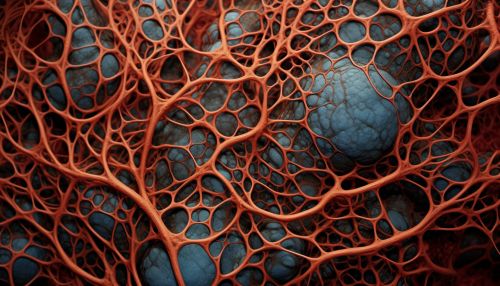Glomeruli
Anatomy and Structure
Glomeruli are a key component of the nephron, the basic functional unit of the kidney. They are tiny, capillary-rich structures involved in the filtration of blood to form urine. Each kidney contains approximately one million glomeruli.


The structure of the glomerulus is complex and specialized to facilitate its function. It consists of a tuft of capillaries, known as the glomerular capillaries, surrounded by a double-walled capsule, the Bowman's capsule. The inner wall of the Bowman's capsule, known as the visceral layer, is composed of specialized cells called podocytes. These cells have long foot processes that interdigitate with each other, leaving filtration slits in between. The outer wall, or the parietal layer, is composed of simple squamous epithelium.
The glomerular capillaries are unique in that they are both fed and drained by arterioles - the afferent and efferent arterioles, respectively. This dual arteriole system maintains high pressure within the glomerulus, which is essential for the process of ultrafiltration.
Function
The primary function of the glomerulus is to perform the first step in the filtration of blood to form urine. This process, known as glomerular filtration, involves the removal of waste products, electrolytes, and water from the blood.
The high pressure within the glomerulus forces water and solutes from the blood in the glomerular capillaries across the filtration barrier and into the Bowman's capsule. This filtration barrier is composed of the fenestrated endothelium of the capillaries, the glomerular basement membrane, and the filtration slits between the foot processes of the podocytes.
The filtrate that enters the Bowman's capsule is essentially protein-free plasma. It then flows into the renal tubules where it is further processed to form urine.
Pathology
Glomerular diseases are a common cause of kidney disease. They can occur as a result of damage to the glomeruli, which can be caused by a variety of conditions including diabetes, hypertension, and autoimmune diseases.
Glomerulonephritis is a type of kidney disease characterized by inflammation of the glomeruli. It can be caused by infections, drugs, or systemic diseases. Symptoms can include proteinuria (excessive protein in the urine), hematuria (blood in the urine), and reduced glomerular filtration rate leading to waste accumulation in the blood.
Another common glomerular disease is diabetic nephropathy, a complication of diabetes that results in damage to the glomeruli due to high blood sugar levels. Over time, this can lead to chronic kidney disease and end-stage renal disease.
Clinical Significance
The health of the glomeruli is crucial for the overall function of the kidneys. Glomerular diseases can lead to significant morbidity and mortality, and early detection and treatment are essential to prevent progression to kidney failure.
Measurement of the glomerular filtration rate (GFR) is a common clinical test used to assess kidney function. It provides an estimate of the volume of plasma that is filtered by the glomeruli per unit time. A decrease in GFR can indicate kidney disease.
Urinalysis is another common test used in the evaluation of glomerular function. The presence of proteins or blood in the urine can suggest damage to the glomeruli.
